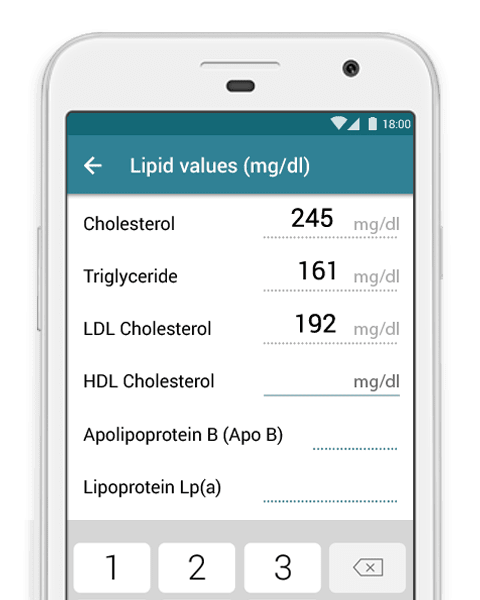The amount of cholesterol circulating in your body, and the levels of the different lipoproteins in which they are transported, is particularly significant when it comes to your risk of developing heart disease. Getting enough exercise has many heart-healthy benefits: is lowering your cholesterol levels one of them?
Why Cholesterol Matters
Cholesterol is commonly referred to as being either “good” HDL cholesterol or “bad” LDL cholesterol. However, cholesterol is actually only one substance. Because it’s fatty and insoluble in water, it needs to be transported along with proteins. Fats (lipids) + proteins = lipoproteins. HDL stands for high-density lipoprotein and LDL stands for low-density lipoprotein.
The other main types of lipoproteins are very low-density lipoproteins (VLDL), chylomicrons and intermediate-density lipoproteins (IDL). Aside from cholesterol, they carry other fats (such as triglycerides) and proteins around the body in differing ratios.
Cholesterol itself is fundamental to your very survival: contributing to cell building and hormone production are among its job roles. However, too much of it – particularly when being transported in LDL particles – can accelerate the build-up of plaque on artery walls. The process of plaque building up on artery walls is called atherosclerosis and is central in the development of heart disease and increases your risk of a heart attack.
This YouTube video does a good job of explaining and visually representing the process of atherosclerosis.
The job of HDL largely involves collecting excess cholesterol from circulation and transporting it back to the liver for disposal. It is actually the only lipoprotein that has been shown to offer protection from heart disease. You cannot have too much HDL, which is why your total cholesterol level only paints part of the picture regarding your risk of heart disease. Measurements such as non-HDL level can provide additional insight.
You can read a bit more about that here:
Lipoprotein Particle Size
Researchers believe that it is not only your levels of different lipoproteins that determine your risk of heart disease but also the physical size of the particles.
In particular, small, dense LDL (sd-LDL) particles have been found to increase your risk of cardiovascular complication.
As a result, it has been argued that the actual number of LDL particles – your LDL-p number – is the most important marker of them all, as this closely correlates to particle size.
What all of this goes to show is that cholesterol is far from binary: it is more complicated than “good” HDL and “bad” LDL cholesterol. It also means that someone with a high total cholesterol level is not necessarily at an increased risk of heart disease, depending on the make-up and characteristics of the lipoproteins.
It is worth bearing all of this in mind when considering the effect lifestyle choices, such as exercise, have on cholesterol and your risk of cardiovascular complications.
Other posts you may be interested in on the MyTherapy blog:
- Alcohol and Cholesterol: Can a Drink a Day Really Help Your Heart?
- Heart Rate Monitoring with Smartphones and Wearables: What You Need to Know
How Lifestyle Affects Cholesterol
Your body closely regulated your cholesterol levels and around 75% to 80% of the cholesterol in your body is produced in the liver. The effect lifestyle has on your cholesterol levels is, therefore, a hotly debated topic.
For example, the long-held belief that eating saturated fat increases cholesterol levels and subsequently your risk of heart disease is now widely disputed, as you can read about here:
Nonetheless, there is evidence to suggest that exercise can make a significant difference in your cholesterol levels.
The Effect of Exercise on Cholesterol
The benefits of exercise extend far beyond simply improving your fitness. From the hormonal response that can improve your mental wellbeing to increasing antioxidant enzymes that help keep your skin healthy, there are few parts of the body that don’t benefit from exercise.
It also appears to improve your cholesterol levels.
The way in which it does so is not well understood. However, there is a body of evidence that shows exercise helps lower LDL, VLDL, and triglyceride levels while boosting HDL levels. Even in studies where total cholesterol levels remained consistent, such as this one, the HDL:LDL ratio improved significantly.
A review published in 2014 looked at results from 13 studies and two review articles, regarding aerobic exercise, resistance training, and a combination of the two. It found:
Aerobic Training
Aerobic training, such as jogging, running, and cycling, was found to improve cholesterol levels at different rates depending on volume and intensity.
Regarding intensity, a moderate-intensity workout is usually one where you train at about 50%-70% of your maximum heart rate, while a high-intensity workout is one in which you reach between 70% and 85% (your maximum heart rate is often quoted as being 220 minus your age. This is not perfect, but it gives you a ballpark estimate).
Volume is rather subjective depending on your fitness level and ability, although one study analyzed considered high-volume aerobic training to be jogging for the calorific equivalent of 20 miles/week and low volume to be the equivalent of 12 miles/week.
Accounting for the intricacies of each study analyzed, researchers concluded that a moderate-intensity exercise program has the most noticeable effect on HDL levels, which were improved across the board. As intensity increases, other markers, such as LDL and triglyceride levels, are more likely to improve as well.
What’s more, there is also evidence that endurance exercise – independent of diet – also decreases the concentration of small, dense LDL particles. As mentioned previously, a high sd-LDL level is considered a greater risk factor for heart disease than other markers.
The subsequent advice is that most people should incorporate aerobic exercise into their lifestyle, within personal boundaries. Performing >30 minutes of moderate- to high-intensity training (again, depending on personal capability) 5 times per week has the potential to significantly improve cholesterol levels.
Resistance Training
Resistance training develops aspects such as strength rather than cardio fitness, using either your own body weight or objects such as dumbbells as resistance.
The results between different studies are rather inconsistent, although all show some effect on cholesterol levels. Intensity is measured as a percentage of the maximum an individual can lift for one repetition (known as ‘1 RM’).
One study, interestingly, found that low- to moderate-intensity training (50-75% 1 RM) to be more beneficial to cholesterol levels that high intensity (90%+).
Another found improvements to LDL levels, total cholesterol levels, and HDL:LDL ratios were similar in both moderate- and high-intensity workouts, while increased HDL levels were only present in the high-intensity group.
A further study ignored the intensity and focused instead on volume, with participants completing three 60-minute workouts per week for one month and four sessions for the following month. Again, significant improvements were noted.
As is the case with aerobic exercise, quite how resistance training effects cholesterol levels is not understood. While it is believed that aerobic exercise has a greater effect, the benefit of resistance training is that it is accessible to more people. As such, resistance training can supplement or enhance aerobic training for most people.
For those who are unable to perform aerobic exercise for whatever reason, performing resistance training instead is far better than doing nothing at all.
Aerobic & Resistance Training Combined
While aerobic and resistance training have each demonstrated benefits, not many studies have investigated the effects of combining the two. One such study did find 45 minutes of moderate-intensity aerobic exercise followed by two sets of 15 repetitions at 60% 1 RM did significantly reduce LDL cholesterol levels. However, the improvement was similar for those who only performed the aerobic element of the workout.
Aside from that, the studies comparing both types of exercise performed together to each performed independently is lacking.
From the evidence available, the researchers concluded that aerobic training is the most effective way of improving the lipid profile of most people. Additional resistance training can supplement or enhance these benefits, while resistance training alone is a worthwhile alternative if aerobic training is not possible for whatever reason.
Other Benefits of Exercise to the Heart & Body
Exercise can do more for your heart than just improving your cholesterol levels. Other benefits include:
- Lowering your blood pressure
- Reducing your heart rate
- Helps your body manage blood sugar and insulin levels, which lowers your risk for type 2 diabetes
- Along with a healthy diet, helps you manage your weight
Aside from your heart, exercise is capable of improving your mood, strengthening bones and muscles, keeping your skin healthy, improving your brain function, reduce pain, improving your sex life, and helping you sleep better. It may even protect against chronic illnesses and Alzheimer’s disease.
The Risks Associated with Exercise
The most obvious risk of exercise, whether aerobic or resistance, is an injury. This can be mitigated by not pushing yourself too far, too soon, and by receiving coaching.
Aside from injury, serious complications such as heart attacks or cardiac arrest usually only occur in people with an underlying condition. If you live with heart disease, diabetes, kidney disease, arthritis, high blood pressure, or any other condition that may put you at risk, you should speak to your doctor about how to safely incorporate exercise into your lifestyle.
It is believed to be possible to exercise too much. For example, people who run marathons for years on end may be at greater risk of coronary artery calcium. And while that is at the extreme end of the scale, sports such as running may cause long-term damage to your joints (although this is subject to debate).
Nonetheless, the benefits of a structured exercise regime vastly out-weight the possible negatives for the majority of people, not least when it comes to the health of your heart. Considering the list of benefits above is not even comprehensive, the number of ways exercise improves your health is extraordinary. As Dr. Mark Tarnopolsky told Time:
“If there were a drug that could do for human health everything that exercise can, it would likely be the most valuable pharmaceutical ever developed.”
Learn more about statins on our DrugWiki FAQ:
Take a look at some of the other posts on the MyTherapy blog:



